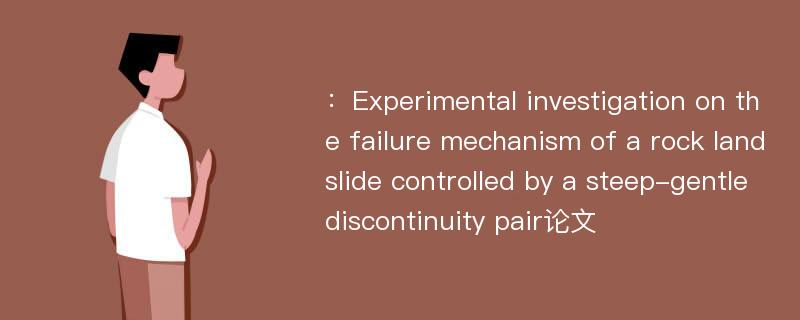
本文主要研究内容
作者(2019)在《Experimental investigation on the failure mechanism of a rock landslide controlled by a steep-gentle discontinuity pair》一文中研究指出:A type of rock landslide is very common in practical engineering, whose stability is mainly controlled by the rock bridge between the steep tensile crack at the crest and the low-inclination weak discontinuities at the toe(namely, ligament is the term for the locking section in the slope). To obtain a deeper understanding into the failure process of this kind of landslide, twenty-four physical slope models containing a steep-gentle discontinuity pair(a steep crack in the upper part and a low-inclination discontinuity in the lower part) were tested by applying vertical loads at the crests. The results indicate that the inclination angle of the ligament(θ) has great influence on the failure and stability of this type of rock slope. With the change of θ, three failure patterns(five subtypes) concerning the tested slopes can be observed, i.e., tensile failure of the ligament(Type 1), tension-shear failure of the ligament(Type 2) and two-stage failure of the main body(Type 3). The failure process of each failure mode presents five stages in terms of crack development, vertical load, horizontal/vertical displacements and strains in the ligaments. The specific range of the ligament angle between different failure patterns is summarized. The discussion on the failure resistances and ductility of different failure patterns, and the guiding significances of the experimental findings to the stability evaluation and the reinforcement were conducted.
Abstract
A type of rock landslide is very common in practical engineering, whose stability is mainly controlled by the rock bridge between the steep tensile crack at the crest and the low-inclination weak discontinuities at the toe(namely, ligament is the term for the locking section in the slope). To obtain a deeper understanding into the failure process of this kind of landslide, twenty-four physical slope models containing a steep-gentle discontinuity pair(a steep crack in the upper part and a low-inclination discontinuity in the lower part) were tested by applying vertical loads at the crests. The results indicate that the inclination angle of the ligament(θ) has great influence on the failure and stability of this type of rock slope. With the change of θ, three failure patterns(five subtypes) concerning the tested slopes can be observed, i.e., tensile failure of the ligament(Type 1), tension-shear failure of the ligament(Type 2) and two-stage failure of the main body(Type 3). The failure process of each failure mode presents five stages in terms of crack development, vertical load, horizontal/vertical displacements and strains in the ligaments. The specific range of the ligament angle between different failure patterns is summarized. The discussion on the failure resistances and ductility of different failure patterns, and the guiding significances of the experimental findings to the stability evaluation and the reinforcement were conducted.
论文参考文献
论文详细介绍
论文作者分别是来自Journal of Mountain Science的,发表于刊物Journal of Mountain Science2019年06期论文,是一篇关于,Journal of Mountain Science2019年06期论文的文章。本文可供学术参考使用,各位学者可以免费参考阅读下载,文章观点不代表本站观点,资料来自Journal of Mountain Science2019年06期论文网站,若本站收录的文献无意侵犯了您的著作版权,请联系我们删除。
